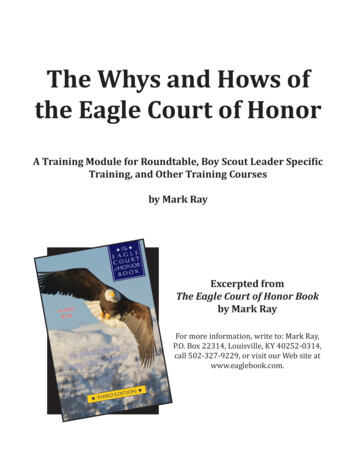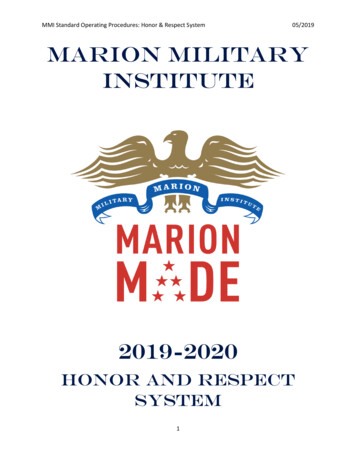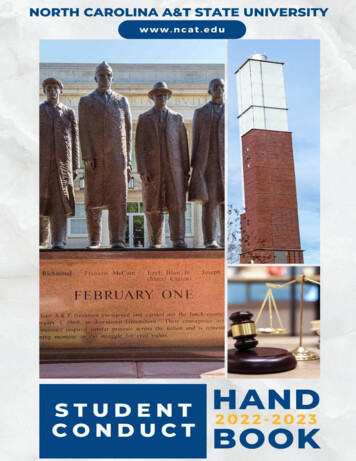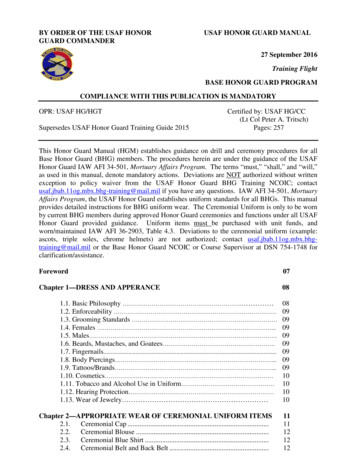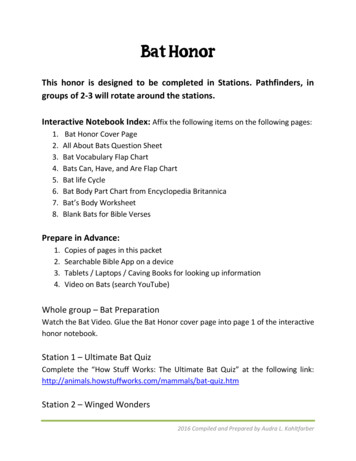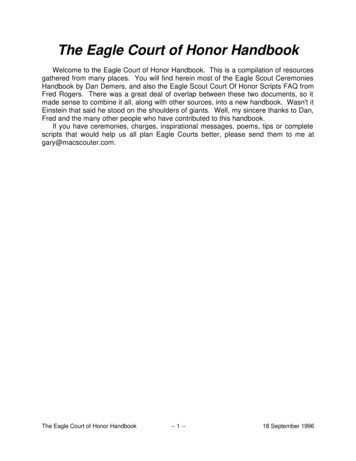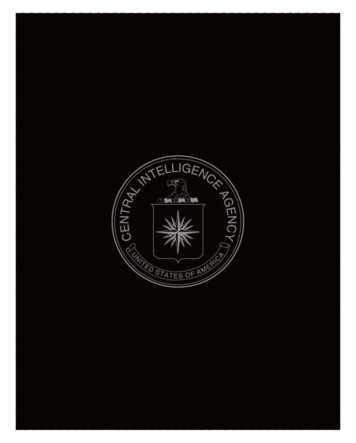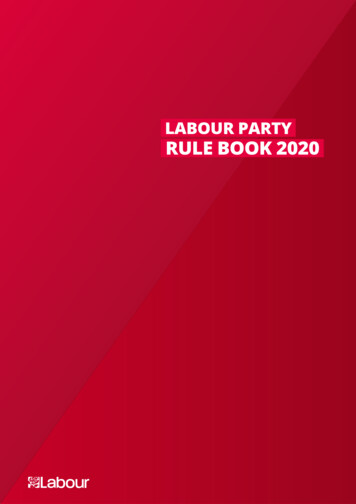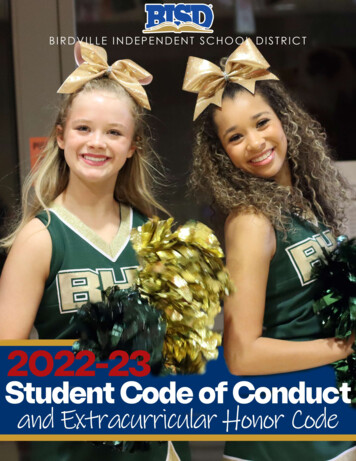
Transcription
Birdville Independent School District6125 E. Belknap Haltom City, Texas 76117 l 817-547-5700 l F A X nt Code of ConductandExtracurricular Honor Codewww.birdvilleschools.netIf you have difficulty accessing the information in this document because of disability,please contact district webmaster Michelle.Doporto@BirdvilleSchools.net817-547-5700
Table of ContentsAccessibility. 1Preamble . 1Campus Behavior Coordinator . 1Threat Assessment and Safe and Supportive School Team. 1Standards and Expectations of Student Behavior . 1Administrative Considerations. 2School District Authority and Jurisdiction . 2Students at School or School-Related Activities . 2Listing of Offenses and Consequences by Level. 4LEVEL I. 4Level I Disciplinary Offenses . 4Level I Disciplinary Options. 4LEVEL II . 5Level II Disciplinary Offenses. 5Level II Disciplinary Options . 5LEVEL III. 5Level III Disciplinary Offenses . 5Level III Disciplinary Options . 7LEVEL IV. 7Level IV Serious Offenses . 7Mandatory Removal/Placement. 7Discretionary Placements. 8Level IV Disciplinary Options. 10LEVEL V (Expulsion to JJAEP) . 10Mandatory Expulsion. 10Discretionary Expulsion. 11Disciplinary Option:. 12Students Under Ten Years of Age . 12DAEP and Newly Enrolled Students . 12DAEP Review. 12Graduating Senior’s to DAEP or JJAEP. 13Procedural Due Process . 13
District Alternative Education Placement (DAEP). 13Expulsion to Juvenile Justice Alternative Education Program (JJAEP). 14Appeals . 15Limited Appeal of Certain Administrative Decisions . 15Appeal of Campus Administrator’s Placement in the DAEP . 15Appeal of Campus Administrator’s Expulsion to JJAEP . 15Emergency Expulsion . 16Emergency Placement. 16Emergency Expulsion . 16Returning a Student to the Classroom . 17Placement Review Committee. 17Abiding by the Law . 17End of Semester or End of Year Offenses . 17Dress Code . 17Restrictions and Prohibitions . 18Birdville ISD Dress and Grooming Guidelines . 18Basic Principle . 18Violations. 20Enforcement. 20Exceptions. 20Dress Code for DAEP. 21Vandalism or Damage to School Property. 21Sexual Harassment. 21Hazing . 21Tobacco Use. 22Electronic Communication Devices . 22Drug-Alcohol Use. 22Weapons. 23Assaults . 23Criminal Trespass . 24Dating Violence . 24Disturbing School or Classes . 25Disruption of Lawful Assembly. 25Prior Review of Written Materials. 26
Student Conduct on School Buses . 26Disciplinary Options for Transportation Referrals . 27Secret or Self-Perpetuating Societies. 27Teacher Removal of a Student. 27Informal Discretionary Removal . 27Formal Discretionary Removal. 27Mandatory Removal by a Teacher. 28Suspension . 29Detention. 29Searches . 29School District Authority and Jurisdiction . 30Search of Students’ Desks and Lockers. 30Reporting Crimes . 30Security Personnel . 30Cooperation with Law Enforcement Officials. 31Probation Officer or Police Questioning of Students . 31Arrested Students . 31Notification of Law Violations . 31Videotaping of Students, Teachers, and other School Employees . 32Extracurricular Honor Code. 32Jurisdiction. 32On-Campus Behavior. 33Off-Campus Behavior. 33Off-Campus Consequences. 34Non-Inclusive Example of Disciplinary Consequences for Off-Campus. 34Appeal Process. 35Extracurricular Honor Code Acknowledgement . 36APPENDIX – DEFINITIONS. 37
AccessibilityIf you have difficulty accessing the information in this document because of disability, pleasecontact Michelle DoPorto, (District Webmaster), michelle.doporto@birdvilleSchools.netor 817-547-5700.PreambleThis Student Code of Conduct has been adopted by the Birdville IndependentSchool District board of trustees and developed with the advice of the district-level Student Codeof Conduct planning and decision-making committee. It provides information to parents andstudents regarding standards of conduct, consequences of misconduct, and proceduresfor administering discipline. This Code remains in effect during summer school and at all schoolrelated events and activities outside the school year until the board adopts an updated version forthe next school year.Campus Behavior CoordinatorAs required by law, a person at each campus must be designated to serve as the campus behaviorcoordinator. The designated person may be the principal of the campus or any other campusadministrator selected by the principal. The campus behavior coordinator is primarily responsiblefor maintaining student discipline. The district shall post on its website and in the StudentHandbook, for each campus, the email address and telephone number of the person serving ascampus behavior coordinator. Contact information may be found at www.birdvilleschools.net andat www.birdvilleschools.net/studenthandbooks.Please see the Birdville ISD District of Innovation – Local Innovation Plan IV-G for moreinformation.Threat Assessment and Safe and Supportive School TeamThe campus behavior coordinator or other appropriate administrator will work closely with thecampus threat assessment safe and support school team to implement the district’s threatassessment police and procedures, as required by law, and shall take appropriate disciplinary actionin accordance with the Code of Conduct.Standards and Expectations of Student BehaviorAll students are entitled to enjoy the basic rights of citizenship recognized and protected by lawfor persons of their age and maturity. The school will foster a climate of mutual respect for therights of others. Students are expected to respect the rights and privileges of other students,teachers, and district staff. The district’s rules of conduct and discipline are established to achieveand maintain order in the school. Students who violate the rights of others or who violate districtor school rules will be subject to disciplinary measures designed to correct the misconduct and topromote adherence by all students to their responsibilities as citizens in the school community.Page 1
Administrative ConsiderationsThe Texas Education Code now requires the Student Code of Conduct to specify that the districtwill consider self-defense, intent, disciplinary history, and disability when making decisionsregarding a student’s out-of-school suspension, placement in a DAEP, expulsion, or placement ina JJAEP, regardless of whether the decision involves a mandatory or discretionary action.Previously, consideration of these factors was left to the district’s discretion.This Handbook is designed to be in harmony with Board Policy. State Law allows annual updates,but policy adoption and revisions may occur throughout the year. Changes in policy that affectthese will be made available to students and parents through newsletters and othercommunications. In case of conflict between Board Policy and any provisions of this Code ofConduct Book, the provisions most recently adopted by the Board of Trustees will be followed.School District Authority and JurisdictionSchool rules and the authority of the district to administer discipline apply whenever the interestof the district is involved, on or off school grounds, in conjunction with or independent of classesand school-sponsored activities.The district has disciplinary authority over a student:1. During the regular school day and while the student is going to and from school or a schoolsponsored or school related activity on district transportation.2. During lunch periods in which a student is allowed to leave campus.3. While the student attends any school-related activity, regardless of time or location.4. For any school-related misconduct, regardless of time or location.5. When a threat against or retaliation against a school employee, board member, or volunteeroccurs regardless of time or location.6. When a student engages in cyberbullying, as provided by Education Code 37.0832.7. When criminal mischief is committed on or off school property or at a school-related event.8. For certain offenses committed within 300 feet of school property as measured from anypoint on the school’s real property boundary line.9. For certain offenses committed while on school property or while attending a schoolsponsored or school-related activity of another district in Texas.10. When the student commits a felony, as provided by Education Code 37.006 or 37.0081.11. When the student is required to register as a sex offender.Students at School or School-Related ActivitiesStudent responsibilities for achieving a positive learning environment at school or schoolrelated activities include:1.2.3.4.Attending all classes daily and on time.Being prepared for each class with proper materials and assignments.Being appropriately dressed, following the district’s dress code.Exhibiting respect towards others.Page 2
5.6.7.8.9.Behaving in a responsible manner.Paying required fees and fines unless they are waived.Refraining from violations of the Student Code of Conduct.Obeying all school rules, including safety rules.Exhibiting responsible conduct at school, on school buses, and at all school functions onor off campus.10. Cooperating with staff in investigations of disciplinary cases and volunteering informationrelating to a serious offense.Students at school or school-related activities are prohibited from:1. Engaging in academic dishonesty, which includes cheating or copying the work of anotherstudent, plagiarism, and unauthorized communication between students duringan examination.2. Leaving school-sponsored events without permission.3. Directing profanity, vulgar language, or obscene gestures toward other student.4. Insubordination, such as disobeying directives from school personnel of school policies,rules, and regulations.5. Being disrespectful or directing profanity, vulgar language, or obscene gestures towardsteachers or other school employees.6. Playing with matches, fire or committing arson,7. Committing robbery or theft.8. Damaging or vandalizing property owned by the district, other students, or districtemployees.9. Disobeying school rules about conduct on school buses.10. Fighting, committing physical abuse, or threatening physical abuse.11. Committing extortion, coercion, or blackmail; that is, obtaining money or other objects ofvalue from an unwilling person, or forcing an individual to act through the use or threat offorce.12. Engaging in verbal abuse, i.e., name-calling, ethnic or racial slurs, or derogatory statementsthat may substantially disrupt the school program or incite violence.13. Engaging in inappropriate physical or sexual contact disruptive to the school environmentor disturbing to other students.14. Engaging in any other conduct that disrupts the school environment or educational process.15. Committing indecent exposure.16. Being tardy or leaving school grounds when not permitted to do so.17. Engaging in any conduct constituting felony criminal mischief, as defined by law.18. Engaging in any unruly, disruptive or abusive behavior that seriously interferes withteacher communications, with students, with students’ ability to learn, or with theeducational process.19. Violation of district policy for acceptable use of computers, networks, and other electroniccommunication devices.20. No skating or skateboarding on campuses.Page 3
Listing of Offenses and Consequences by LevelLEVEL ILevel I Disciplinary OffensesLevel I act(s) of misconduct include repeated infractions of classroom managementprocedures or rules or other misconduct that disrupts the educational process. The followingis a non-inclusive list of behavior infractions:1.2.3.4.5.6.7.Being tardy to classRefusing to follow classroom rules.Refusing to participate in classroom activities or complete assignments.Failure to bring appropriate materials to class.Unauthorized use of any item or electronic device that causes class disruption.Disruption of the orderly classroom process.Running, making excessive noise, obstructing, or other disruptions in halls, buildings,classrooms, or other supervised settings.8. Dress code violations.Level I Disciplinary OptionsThe classroom teacher may use one or more of the following consequences:1. Warning.2. Teacher/student conference.3. Parent conference or parent communication.4. In-class disciplinary actions or assignments.5. Withdrawal of student privileges.6. Campus determined detention.7. Confiscation of disruptive items or materials.8. Supervised campus service agreement.9. Student assigned temporary seating in another classroom.10. Create or Review Behavioral RtI Tier Level.11. Create or Review Threat Assessment.Page 4
LEVEL IILevel II Disciplinary OffensesWhen a student’s behavior does not change because of action taken at Level I, and the studentis being seen in an administrator’s office for a repeated Level I infraction, the student is movedto Level II for discipline purposes.1.2.3.4.5.Repeated violations of Level I offenses.Bullying or Cyber bullying.Impeding an administrative investigation.Unexcused absences or tardies.Academic dishonesty, which includes cheating or copying the work of another student,plagiarism, or unauthorized communication between students during an examination.6. Campus Administration or designee must be involved or informed in the investigation ofall incidents of academic dishonesty and a determination must be made whether the offenseoccurred.7. Possession or use of nicotine vapes, electronic cigarettes, tobacco or tobacco free products(including snuff, dissoluble tobacco).Level II Disciplinary OptionsOne or any combination of the following or a lower-level consequence may be applied:1.2.3.4.5.6.7.8.9.Any discipline consequence outlined in Level I.Conference including Teacher, Parent, Student, Counselor or Administrator.Campus determined detention.In-school suspension up to three days.Friday Night School or Saturday School.Grade penalty for academic dishonesty.Stay Away Agreement initiated.Create or Review Behavioral RtI Tier LevelCreate or Review Risk Assessment PlanLEVEL IIILevel III Disciplinary OffensesLevel III acts of misconduct include those student infractions, which are somewhat moreserious than those in Level I and Level II due to their effect on the orderly process of theschool program or endanger or seriously affect other students.Examples of misconduct include, but are not limited to, the following:1. Repeated violations of Level II offenses.2. Not attending detention or repeatedly failing to attend detention or refusing to attenddetention.Page 5
3. Repeated violations of possession or use of tobacco or tobacco free products (includingsnuff, dissoluble tobacco, or electronic cigarettes).4. Bullying or Cyber bullying – Discipline will be administered following HB 1942 of the82nd Legislature.5. Posting on social media while student is off campus and is not in attendance at a schoolsponsored event if the conduct results in a material or substantial disruption of the schoolenvironment or interference with school operations.6. Posting on social media while on school property, in attendance at a school sponsoredevent, or using school technology resources, if the conduct interferes with schooloperations or cause a disruption of the learning environment.7. Leaving the classroom, building, grounds, or assigned activity without permission.8. Repeated violation of the school district dress code.9. Using profane, obscene, indecent, racially, or ethnically offensive language and or physicalgestures or symbols to other students or adults.10. Insubordination or defiance of authority. Being disrespectful towards school personnel orby refusing to comply with lawful requests or directions of school personnel.11. Truancy, excessive absences or tardies (3 unexcused absences in a four-week period or 10unexcused absences in a six-month period). Including repeated early dismissals at theelementary school level.12. Altering school records or documents, or forgery of a name on school documents.13. Criminal Mischief or Vandalism to or defacing school property.a. 13.1 Class C Misdemeanor 100b. 13.2 Class B Misdemeanor 100 to less than 750c. 13.3 Class A Misdemeanor 750 to less than 2,500d. State Jail Felony 2,500 to less than 30,00014. Repeated engagement in public displays of affection (PDA).15. Exhibiting or using electronic communication device(s) or cellular telephones during theinstructional day in violation of Board Policy FNCE (LOCAL). [Repeated violations ofcell phone usage can result in loss of privilege of carrying cell phones.]16. Throwing or irresponsible use of objects that can cause bodily injury or damage to property.17. Exhibiting any unacceptable or unwanted physical contact that could but does not result ininjury.18. Recklessness in an automobile on campus.19. Damaging property of others.20. Possessing a pocketknife, or a look-alike weapon.21. Violation of BISD Telecommunication Acceptable Use Policy.22. Threats, oral, written, or electronic, to do bodily harm to another, or to the property ofanother.23. Posting or distributing unauthorized or inappropriate illegal materials, (paper or electronic)on school premises.24. Possession of fireworks or any flammable device, including lighters.25. Discharging air horns or odor emitting devices.26. Fighting.27. Theft.28. Enter, without authorization, district facilities that are not open for operations.Page 6
Level III Disciplinary OptionsAny one or any combination of the following or a lower level may be applied: Any combinationof discipline techniques outlined in Level I or II.1. Grade penalty for copying or cheating from Internet, or plagiarism or other electronicmeans2. Campus determined detention.3. Exclusion from extracurricular activities.4. In-school suspension not to exceed three days at a time.5. Restoration or restitution.6. Withdrawal of selected student privileges.7. Supervised campus service agreement.8. Out-Of-School Suspension not to exceed three days at a time.9. Placement in the District Alternative Education Program.10. Involvement of law enforcement personnel.11. Confiscation of prohibited items.12. Saturday School or Friday Night School.13. Referral to BISD Truancy Officer.14. Suspend or terminate use of BISD electronic or communication equipment.15. Create review Behavioral RtI Tier Level16. Create review Risk Assessment PlanLEVEL IVLevel IV Serious OffensesLevel IV offenses include those acts of misconduct that seriously disrupt the educationalprocess, endanger, or seriously affect other students, as determined by administration, andviolate the law. Examples include, but are not limited to the following:Mandatory Removal/PlacementIf a student commits any of the following acts while within 300 feet of school property asmeasured from any point on the school’s real property boundary line, or while attending aschool-sponsored or school-related activity on or off the property, he or she shall be removedto an alternative education program.1. Engaging in conduct relating to a false alarm or report (including bomb threat) or aterroristic threat involving a public school as defined by Penal Code 42.062. Engages in conduct punishable as a felony.3. Commits assault as defined by Penal Code 22.01.a. Assault (no bodily injury) with threat of imminent bodily injury; Penal Code22.01(a)(2)b. Assault by offensive or provocative physical contact; Penal Code 22.01 (a)(3)4. Makes a terrorist threat as defined by Penal Code 22.07.Page 7
5. Sells, gives, or delivers to another person or possesses, uses, or is under the influenceof marijuana, a controlled substance, or a dangerous drug in an amount not constituting afelony offense. A student with a valid prescription for low-THS cannabis as authorized byChapter 487 of the Health and Safety Code does not violate this provision. Sells, gives, ordelivers to another person an alcoholic beverage; commits a serious act or offense whileunder the influence of alcohol; or possesses, uses or is under the influence of alcohol, if theconduct is not punishable as a felony offense. Behaves in a manner that contains theelements of an offense relating to abusable volatile chemicals under 485.031 through483.035, Health and Safety Code, or other volatile chemicals under Chapter 484, Healthand Safety Code.6. Engages in public lewdness under Penal Code 21.07.7. Engages in indecent exposure under Penal Code 21.08.8. Engages in consensual sexual activity.9. Engages in retaliation against a school employee under Penal Code 36.06 except, in thestudent commits a mandatory expellable offense against any employee in retaliation for orbecause of the employee’s employment with the school district, the student must beexpelled under TEC 37.007.10. Engages in conduct punishable as a felony as def
1. Engaging in academic dishonesty, which includes cheating or copying the work of another student, plagiarism, and unauthorized communication between students during an examination. 2. Leaving school-sponsored events without permission. 3. Directing profanity, vulgar language, or obscene gestures toward other student. 4.
